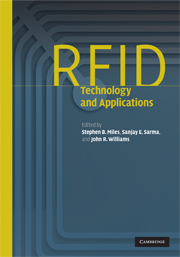Book contents
- Frontmatter
- Contents
- List of contributors
- Preface
- Acknowledgments
- 1 Introduction to RFID history and markets
- 2 RFID technology and its applications
- 3 RFID tag performance optimization: a chip perspective
- 4 Resolution and integration of HF and UHF
- 5 Integrating sensors and actuators into RFID tags
- 6 Performance evaluation of WiFi RFID localization technologies
- 7 Modeling supply chain network traffic
- 8 Deployment considerations for active RFID systems
- 9 RFID in the retail supply chain: issues and opportunities
- 10 Reducing barriers to ID system adoption in the aerospace industry: the aerospace ID technologies program
- 11 The cold chain
- 12 The application of RFID as anti-counterfeiting technique: issues and opportunities
- 13 Closing product information loops with product-embedded information devices: RFID technology and applications, models and metrics
- 14 Moving from RFID to autonomous cooperating logistic processes
- 15 Conclusions
- Appendix – links to RFID technology and applications resources
- Editor biographies
- Index
- References
4 - Resolution and integration of HF and UHF
Published online by Cambridge University Press: 02 November 2009
- Frontmatter
- Contents
- List of contributors
- Preface
- Acknowledgments
- 1 Introduction to RFID history and markets
- 2 RFID technology and its applications
- 3 RFID tag performance optimization: a chip perspective
- 4 Resolution and integration of HF and UHF
- 5 Integrating sensors and actuators into RFID tags
- 6 Performance evaluation of WiFi RFID localization technologies
- 7 Modeling supply chain network traffic
- 8 Deployment considerations for active RFID systems
- 9 RFID in the retail supply chain: issues and opportunities
- 10 Reducing barriers to ID system adoption in the aerospace industry: the aerospace ID technologies program
- 11 The cold chain
- 12 The application of RFID as anti-counterfeiting technique: issues and opportunities
- 13 Closing product information loops with product-embedded information devices: RFID technology and applications, models and metrics
- 14 Moving from RFID to autonomous cooperating logistic processes
- 15 Conclusions
- Appendix – links to RFID technology and applications resources
- Editor biographies
- Index
- References
Summary
An act of government, in this case the State of California, is the driving force behind the research topic addressed in this chapter. The use of RFID to establish an ePedigree in the pharmaceutical supply chain brings to a head basic RFID frequency and technology choices that are available from vendors today. This chapter describes how the RFID Center of Excellence at the University of Pittsburgh works with pharmacy distribution and retail as they evaluate different requirements specific to the healthcare life sciences industry.
Different RFID reader environments and the physics of RFID that impact systems performance, including fundamentals of orientation, are characterized in order to explain different findings from pharmaceutical industry HF RFID pilots and from fast-moving consumer goods retail UHF RFID implementations. Alternatives of HF and UHF, namely near-field and far-field RFID options, are explored (the analogy is to compare an RF environment that is like “a prisoner in a cell” with an RF environment like “a bird in the sky”), and performance models are presented and evaluated with respect to constricted orientation and distance in real-world scenarios. A systematic layered approach for analyzing RFID interrogator-to-tag RF protocols is proposed, an insight that, should it be adopted by reader manufacturers, would dramatically improve RFID reader interoperability and testing. Recommendations are made with respect to modeling RFID systems performance and where pilots can help prepare the way for full implementation of RFID systems.
- Type
- Chapter
- Information
- RFID Technology and Applications , pp. 47 - 60Publisher: Cambridge University PressPrint publication year: 2008
References
- 3
- Cited by



